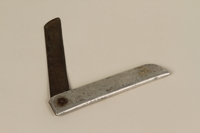Overview
- Brief Narrative
- Aluminum comb made from airplane parts by Yona Wygocka, age 16, in November 1944 when she was a slave laborer in an ammunition factory in Freiburg, Germany. She had been sent there from Auschwitz concentration camp. She used this to comb out her hair as it began to grow back following her transfer from Auschwitz.
- Date
-
creation:
1944 November
- Geography
-
creation:
slave labor factory;
Freiburg (Germany)
- Credit Line
- United States Holocaust Memorial Museum Collection, Gift of Yona Wygocka Dickmann
- Contributor
-
Subject:
Yona Dickmann
- Biography
-
Yona Wygocka was born on March 15, 1928, in Pabianice, Poland, to Natan and Rifka Wygocka. She was the eldest of four children in a working class Jewish family. They were a closeknit extended family and many relatives lived nearby. Her father Natan sold goods to Polish shops, often on a barter system where he traded his merchandise for food. After Germany invaded Poland in September 1939, the Jewish section of Pabianice, where Yona's family lived, was made into a ghetto. Food was very scarce. The Germans made weekly searches where they seized valuables and other belongings from Jewish homes. Next, the Germans began seizing people for forced labor service. In May 1942, the ghetto was liquidated. Yona's mother, brother, and youngest sister were sent to Chelmno killing center and murdered. Yona, her father, and her sister Bluma, 10, were sent to Łódź Ghetto. Yona, then12, and her younger sister were made to work in a factory sewing clothes. There were frequent aktions when people were taken away and deported, and the girls would hide at those times. In August 1944, they were found and taken to Auschwitz concentration camp, along with their aunt Hela. Her sister was sent to the gas chambers and killed. Yona was transferred to work in an airplane factory in Germany. When the Allies began bombing the region, the camp was evacuated. The inmates were taken by train ot Mauthausen. Ten days later, on May 5, 1945, they were liberated by American troops of the 11th Armored Division. With the help of Jewish Brigade members, Yona and Hela got to Italy, where they prepared to emigrate to Palestine. After six moths, they left Italy by ship for Palestine, where they had three uncles, Chaim, Tal, and Avram. Yona settled in Tel Aviv where she met Isaac Dickmann, a fellow survivor from Poland. The couple married in 1948. They immigrated to the United States in 1959 and settled in Washington DC.
Physical Details
- Classification
-
Personal Equipment and Supplies
- Object Type
-
Combs (lcsh)
- Physical Description
- Aluminum comb rounded edges and 30 teeth made from airplane parts.
- Dimensions
- overall: Height: 3.750 inches (9.525 cm) | Width: 1.375 inches (3.493 cm) | Depth: 0.125 inches (0.318 cm)
- Materials
- overall : aluminum
Rights & Restrictions
- Conditions on Access
- No restrictions on access
- Conditions on Use
- No restrictions on use
Keywords & Subjects
Administrative Notes
- Legal Status
- Permanent Collection
- Provenance
- The comb was donated to the United States Holocaust Memorial Museum in 1990 by Yona Wygocka Dickmann.
- Funding Note
- The cataloging of this artifact has been supported by a grant from the Conference on Jewish Material Claims Against Germany.
- Record last modified:
- 2023-09-01 09:42:31
- This page:
- https://collections.ushmm.org/search/catalog/irn2959
Download & Licensing
In-Person Research
- By Appointment
- Request 21 Days in Advance of Visit
- Plan a Research Visit
- Request to See This Object
Contact Us
Also in Yona Wygocka Dickmann collection
The collection consists of a comb and pocket knife relating to the experiences of Yona Wygocka as a prisoner in a salve labor camp in Germany during the Holocaust.
Date: 1944 November

Pocket knife used by a Polish Jewish female slave laborer
Object
Jack knife made from materials salvaged from a saw and airplane parts made by Yona Wygocka circa November 1944 when she was a slave laborer in an ammunition factory in Freiburg, Germany. She had been sent there from Auschwitz concentration camp. . She used the knife to cut her daily portion of bread which she shared with her aunt.



